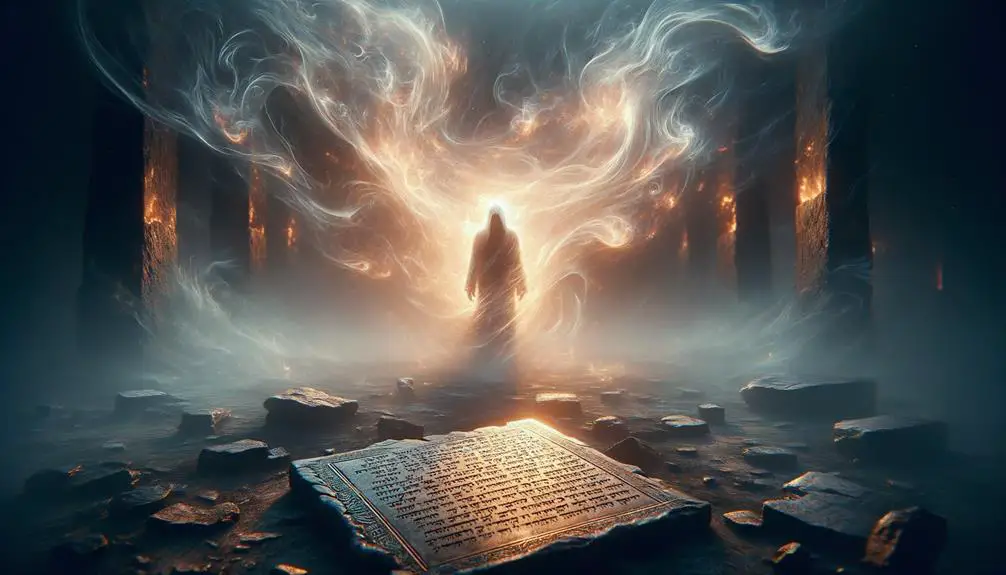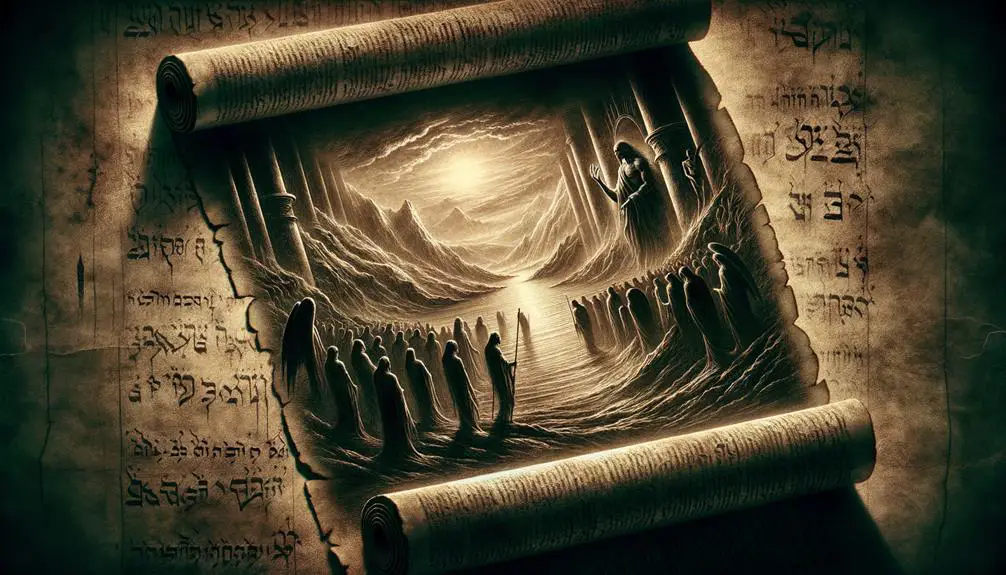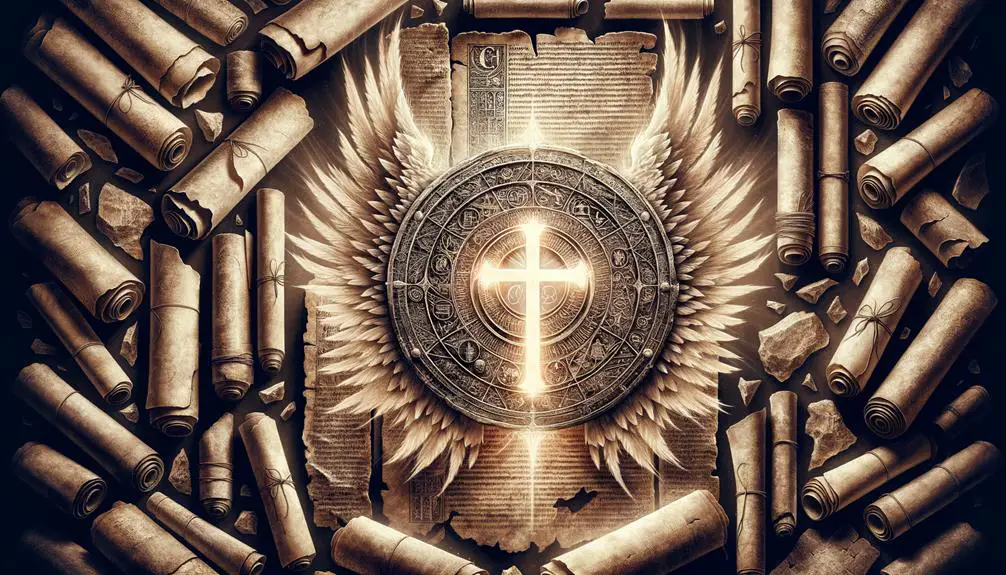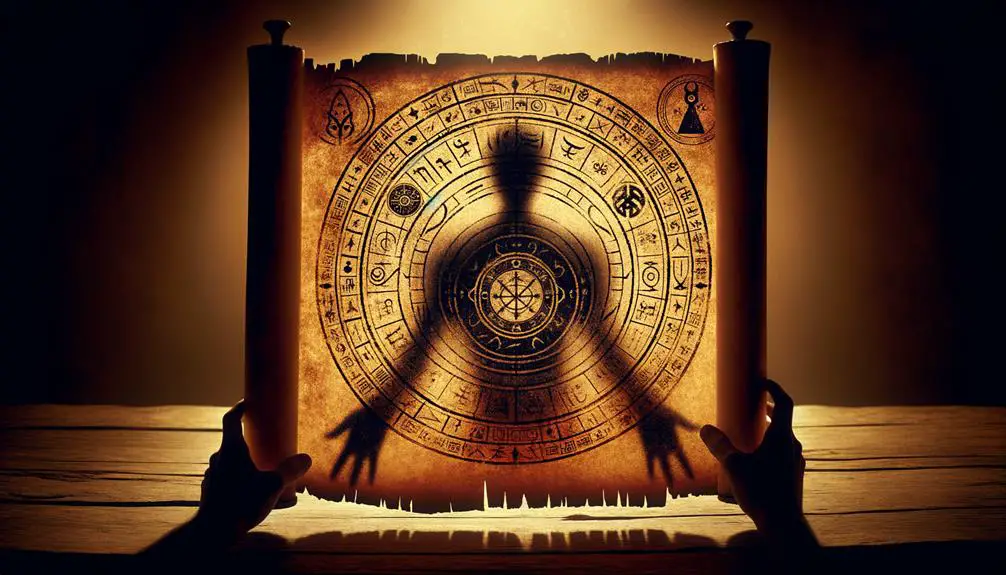This exploration of Belial in the Bible reveals his evolution from a symbol of evil to a complex figure with a deeper narrative significance.

Who Was Belial in the Bible
Have you ever wondered about the shadows lurking in the stories of the Bible, particularly about who Belial was? You're not alone.
This enigmatic figure, whose name surfaces with ominous undertones in the scriptures, has puzzled scholars and the faithful alike for centuries. In the Old Testament, Belial is synonymous with lawlessness and evil, but his presence and influence don't end there.
As you trace his footsteps into the New Testament and beyond, you'll uncover a transition that not only marks a significant evolution in scriptural narrative but also offers insight into the changing face of evil.
What does this shift mean for understanding the complexities of good versus evil in religious texts? Let's explore this shadowy figure's journey together, and perhaps we'll uncover more than we bargained for.
Key Takeaways
- Belial symbolizes profound wickedness and moral decay in biblical texts.
- Initially a term for worthlessness, Belial evolved into a personified evil entity.
- In the New Testament, Belial represents direct opposition to God and Christian morality.
- Belial's legacy influences modern perceptions of evil and ethical dilemmas.
Origins of Belial

The term 'Belial' emerges from ancient Hebrew texts, embodying wickedness and lawlessness in a figure that has evolved significantly through biblical and post-biblical literature. You'll find that Belial's etymology is quite revealing, lending insight into the character's foundational role in these narratives. The word itself is believed to derive from the Hebrew *bliya'al*, which translates to 'without worth' or 'without yoke,' indicating a being that rejects societal norms and divine laws. This etymological understanding underscores Belial's representation as the epitome of evil and chaos, opposing order, morality, and godliness.
As you delve deeper, you'll notice Belial's influence isn't confined to religious texts; it permeates various aspects of culture and has been adapted over centuries. Cultural influences have shaped and reshaped the perception of Belial, with each era casting this figure in light of contemporary understanding and societal fears. In medieval literature, Belial was often depicted as a prince of Hell, a demon lord orchestrating sin and discord among humans. This portrayal reflects the period's preoccupations with morality, sin, and salvation, highlighting how cultural contexts influence the interpretation of such a figure.
Moreover, the evolution of Belial's character serves as a mirror to societal changes and theological debates. From a nebulous embodiment of wickedness in ancient texts to a more personalized demonic entity in later interpretations, Belial's transformations reveal shifts in how evil is conceptualized and confronted. These shifts aren't merely academic; they resonate through sermons, art, and literature, illustrating the enduring impact of Belial's origins on religious and cultural narratives.
Belial in the Old Testament
Within the Old Testament, Belial emerges as a symbol of profound wickedness and moral decay, challenging readers to confront the complexities of evil in biblical narratives. Delving into Belial's etymology offers insights into the multifaceted nature of this figure. The term itself, derived from Hebrew, can be interpreted as 'without value,' hinting at the intrinsic worthlessness and moral bankruptcy associated with entities labeled as such. This linguistic foundation underscores the character's role as an embodiment of sin and corruption, diverging significantly from mere acts of disobedience to signify a profound deviation from divine law.
As you explore the Old Testament, you'll notice that references to Belial aren't personifications of a single demonic entity, but rather, they serve as descriptors for individuals or groups embodying the spirit of lawlessness and moral dissolution. This depiction aligns with the broader theological framework of the Old Testament, which often emphasizes the struggle between righteousness and sin, purity and defilement.
Cultural adaptations of Belial further illuminate the figure's significance in ancient Near Eastern contexts. These adaptations reveal how Belial wasn't only a biblical antagonist but also a symbol integrated into the wider cultural and religious consciousness of the time. Such adaptations underscore the fluidity of Belial's identity, shifting from a generic term for wickedness to a more defined symbol of evil opposition within the cosmic order.
Belial's Transition to the New Testament

Belial's depiction undergoes a significant transformation as you move into the New Testament, reflecting shifts in theological perspectives and socio-religious contexts. Previously recognized in the Old Testament through various manifestations of worthlessness and lawlessness, Belial's representation takes on a more pronounced, malevolent character within New Testament contexts. This evolution underscores the changing dynamics of religious thought and the emerging emphasis on spiritual warfare.
In the New Testament, Belial isn't merely a symbol of general wickedness but becomes more closely associated with direct opposition to God's will and the Christian moral order. This shift is indicative of the early Christian community's efforts to define itself against external and internal threats, with Belial serving as a personification of the ultimate adversary. The heightened dualism between good and evil in this period casts Belial in a starkly antagonistic role, embodying the forces of darkness that Christians must vigilantly oppose.
You'll find that New Testament references to Belial are sparse yet impactful, suggesting a deliberate choice to invoke this figure in situations emphasizing the stark contrast between followers of Christ and agents of iniquity. This strategic use of Belial's depiction serves to reinforce the emergent Christian identity, demarcating the boundary between the community of believers and the wider, non-believing world.
The transition of Belial's depiction from the Old to the New Testament, therefore, isn't merely a change in the characterization of a biblical figure but reflects broader shifts in religious identity, theological discourse, and the socio-religious landscape of early Christianity. This evolution highlights the adaptability of biblical figures to serve the changing needs and concerns of religious communities.
Interpretations and Symbolism
Exploring the myriad interpretations and symbols associated with Belial unveils a complex tapestry of religious and cultural significance that has evolved over centuries. This figure, often depicted as a demon or evil force, carries a weighty demonology significance that extends far beyond the biblical texts, influencing a broad spectrum of cultural narratives and religious ideologies.
- Literal vs. Metaphorical Interpretation: Scholars debate whether Belial represents a specific demonic entity or symbolizes broader concepts of wickedness and lawlessness. This duality enriches the character's interpretive complexity.
- Cultural Impact: Belial's depiction in art, literature, and folklore reflects society's evolving perceptions of evil and morality. Each representation serves as a cultural mirror, revealing contemporary fears and ethical concerns.
- Symbol of Opposition: In many texts, Belial is portrayed as the antithesis of divine virtue, symbolizing the eternal struggle between good and evil. This opposition isn't just a religious motif but also a psychological archetype, resonating with the human condition.
- Eschatological Significance: Belial's role in end-times narratives, particularly in apocryphal and pseudepigraphal literature, underscores the character's importance in discussions of final judgment and the ultimate triumph of good over evil.
The interpretations and symbolism surrounding Belial highlight the character's enduring relevance in discussions of demonology and cultural impact. As you delve deeper into this analysis, it becomes clear that Belial isn't just a biblical antagonist but a multifaceted symbol of human nature's darker aspects and the societal need to personify evil.
Belial's Legacy in Religious Traditions

The legacy of Belial in various religious traditions reveals a profound and multifaceted impact on interpretations of evil and morality across cultures. Belial's influence extends beyond the biblical texts, embedding itself into the fabric of religious discourse and moral philosophy. This figure, often synonymous with lawlessness and wickedness, challenges you to consider the complexities of moral judgment and the embodiment of evil in theological narratives.
In examining Belial's legacy, you uncover layers of interpretation that have evolved over centuries. Early Christian texts depict Belial as a demon or the devil himself, a personification of opposition to divine will. This portrayal has shaped modern perceptions of evil, influencing both religious teachings and popular culture's depiction of malevolent forces.
Furthermore, Belial's impact is evident in the way religious traditions engage with the concept of moral duality. You see this duality reflected in literature, art, and theological debates, where Belial represents the perpetual conflict between good and evil, order and chaos. This binary framework has been critical in shaping ethical discourses within religious contexts, prompting followers to reflect on the nature of sin and redemption.
Belial's influence also extends to contemporary discussions on morality and spirituality. Modern perceptions of Belial, while rooted in ancient texts, are reinterpreted through the lens of current societal and cultural challenges. This ongoing engagement with Belial's legacy demonstrates the enduring relevance of biblical figures in navigating the complexities of modern moral landscapes, offering insights into the human condition and the perpetual struggle between righteousness and iniquity.
Frequently Asked Questions
How Do Modern Religious Scholars Reconcile the Concept of Belial With Contemporary Beliefs About Evil and Morality?
You're diving into how scholars bridge ancient texts with today's views on evil and morality. They explore Belial's etymology, tracing its roots to denote worthlessness or lawlessness, and compare this with modern interpretations of malevolence.
This analysis helps you understand the evolution of the concept of evil. Scholars meticulously dissect these ancient references to align them with contemporary moral frameworks, illustrating how interpretations of texts like these adapt over time.
In What Ways Has the Artistic Representation of Belial Evolved in Western Art From the Medieval Period to the Modern Era?
You've seen Belial's iconography transform dramatically from the medieval period to the modern era. Initially depicted with monstrous traits to symbolize ultimate evil, artists have gradually shifted towards a more symbolic reinterpretation. This evolution reflects changing societal views on evil and morality, moving from literal illustrations to abstract concepts.
Modern depictions often explore the nuances of evil, suggesting a deeper, more complex understanding than earlier, more straightforward representations.
Are There Any Documented Rituals or Practices in Ancient or Medieval Cultures That Were Specifically Dedicated to Worshipping or Appeasing Belial?
When exploring ancient texts, you'll find that Belial's etymology traces back to various cultures, yet there's scant evidence of rituals dedicated specifically to his worship.
Scholars have delved deep into historical documents, but the direct worship or appeasement practices remain elusive. This lack of concrete documentation suggests that if such rituals existed, they were either not widely practiced or simply didn't survive the scrutiny of time in recorded history.
How Do Non-Abrahamic Religions View or Interpret the Figure of Belial, if at All?
In exploring how non-Abrahamic religions perceive Belial, you'll find limited references. Belial in mythology often doesn't cross into these traditions, making comparative demonology challenging.
These religions have their own pantheons and demonic figures, with beliefs that don't typically incorporate Judeo-Christian entities like Belial.
Your investigation into these perspectives reveals a fascinating, albeit sparse, dialogue between different religious mythologies and the figure of Belial.
Can the Influence of Belial Be Seen in Any Modern Legal Systems or Societal Norms, and if So, How?
You're navigating through a minefield when trying to trace Belial's shadow in modern legal systems or societal norms. It's a Herculean task, but not impossible.
While no legal reforms directly cite such a figure, the essence of societal decay—often attributed to malevolent forces in religious texts—mirrors the chaos and moral bankruptcy some associate with Belial.
Analytically, this suggests an indirect influence, shaping norms and laws by embodying the antithesis of societal cohesion.
Conclusion
As you've journeyed through the enigmatic narrative of Belial, from his cryptic origins to his multifaceted role across the scriptures, a pivotal question lingers—what does Belial truly symbolize?
This ancient figure, embodying chaos and opposition, challenges us to reflect on the dualities within our own nature and the broader moral landscape. Belial's legacy, veiled in mystery and contradiction, invites a deeper exploration of the shadows within our collective spiritual heritage.
The answer, it seems, is as elusive as Belial himself.



Sign up